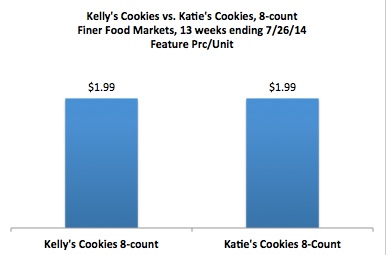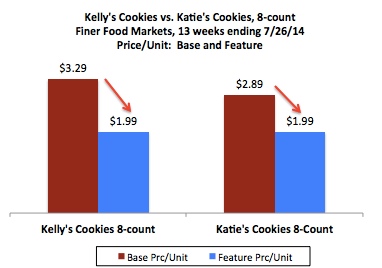
In this post I’ll explain why discount is an important element of your pricing-trade strategy and the correct way to calculate it. (You may want to review these previous posts before continuing: retail pricing in general, base price and trade merchandising measurement.)
We’re all familiar with discounts – everybody likes to get things “on sale.” Shoppers evaluate how good a sale is based on the amount of the discount off the regular price. Discount can be expressed either as an absolute amount or percentage – retailers tell shoppers “ save 75¢ now!” or “35% off!” to let them know when a product is on sale.
If you came across the following prices on competing cookie products, which would you say is the better deal?

OK, so this is a bit of a trick question. Of course you can’t tell which is the better deal unless you also know the regular price of each product, since both brands are on sale for $1.99. Unfortunately, many manufacturers focus primarily on promoted price point when determining the overall pricing and trade strategy, which is like looking at the information above – it’s only half of the picture. So here is some additional information:

Now you can easily see that Kelly’s offers a better deal at the $1.99 price point because it has a higher regular price to start with ($3.29 vs. $2.89). Discount is the way to quantify the difference between regular and promoted prices and compare different deals to each other.
Calculations of Discount
There are 2 ways to think about discount and shoppers do consider both of these, either explicitly or subconsciously.
1. Absolute discount is the amount that the sale price is below the regular price, expressed in dollars or cents.
absolute discount = regular price – sale price
In a Nielsen or IRI database this is sometimes available as a fact. If it’s not, then the facts to use are:
absolute discount = base price – promoted price*
* promoted price can be the price under any of the merchandising tactics (any merch, quality, feature, display, feature & display, TPR)
2. % discount expresses the amount as the percentage the sale price is below the regular price:
% discount = (regular price – sale price) / regular price
In a Nielsen or IRI database this is usually available as a fact. If it’s not, then the facts to use are:
% discount = (base price – promoted price) / base price
(The most common mistake when calculating % discount is to use the wrong denominator! This is the correct one – not average price or promoted price.)
So here is the discount information for our example:

Now you can easily see that Kelly’s is offering a better deal, since you are saving $1.30 (rather than 90¢) and 40% (rather than 31%).
Remember! A higher discount number (absolute or %) is “better,” in that it offers a better deal. We often say “deeper discount” instead of “higher discount” to clarify this.
Comparing Discounts
Here are some of the most common ways that comparing discounts can help inform your price-trade strategy:
- Discount under different merchandising conditions – the same discount level across merchandising conditions result in different lifts. For example, you will sell more product at a 30% discount if you are on display than if there is only a shelf price discount. This will be the topic of a future post.
- Discount vs. year ago – are you offering a similar discount to last year? Of course, this is related to your base and promoted points and how they have changed in relation to each other.
- Discount in different retailers – are shoppers seeing different discounts in different stores? Are some retailers giving you more support (ie – deeper discounts) than others?
- Discount vs. competition – how do your “deals” compare to other products a shopper may consider when also looking at your product?
Of course you need to consider the promoted price point in conjunction with the discount to get the full picture. Neither one alone is enough. If you have the same discount as last year but your base price is higher, then the promoted price would also be higher. If you have the same promoted price as last year but your base price is higher, then your discount is deeper and your lifts will be higher. As in the example above, don’t forget to check to see both promoted prices and discounts that shoppers see for your products vs. the competition.
How do you think about and use discount? Is it different than what I’ve talked about? Please leave a comment for this post.
Did you find this article useful? Subscribe to CPG Data Tip Sheet to get future posts delivered to your email in-box. We publish articles twice a month. We will not share your email address with anyone.

What is the correct way to calculate slope for club packs?
What do you mean by “slope?” I am not familiar with that term. Does it have to with the price of Club pack vs. the price of regular size packs sold in other channels?
Yes I believe that is correct. It is often expressed as an index.